Best Fish for 15 Gallon Tall Tank Updated
Best Fish for 15 Gallon Tall Tank
When information technology comes to choosing the all-time fish for your small tank, y'all're spoilt for choice.
Whether you've got a v gallon, 10 gallon, or 20 gallon nano tank, it's piece of cake to go carried away when planning who will be a role of your community.
This guide has been created to make that decision easier for you. I've created this listing of the absolute best modest fish and their key care information so you can make a quick, educated option.
Past the end of this guide, you lot'll know exactly which small fish is ideal for your aquarium.
1. Chili Rasbora (Boraras Brigittae)
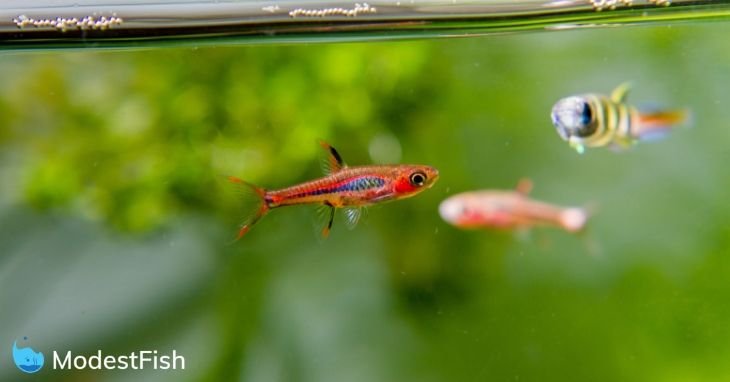
Chili Rasbora, sometimes called musquito rasboras, are tiny tropical ray-finned shoaling fish native to Kalimantan.
Male Chili Rasbora are brightly colored blood-red, with an iridescent black stripe running laterally downward its small torso. Whereas females have circular bellies and lighter color markings in comparison
Simply growing upward to 0.7inches in length, these tiny nano fish practice best in a (minimum) grouping of 8 in a planted peaceful customs tank.
They're active and cute, one of those schooling fish that are e'er doing something when you look in the tank. Yous should keep them in a group of at least
You'll need a planted tank, at least v-gallons, and you can provide them with a protein rich nutrition. Alkali shrimp, Daphnia, and tubifex micro worms are all good choices.
- Mutual names: Chili Rasboras, Mosquito Rasboras
- Scientific Name: Boraras brigittae
- Life Span: viii Years
- Size: 0.7 inches (1.9 centimeters)
- Minimum tank size: five gallons
- Care level: Beginner
- Temperament: peaceful
- Temperature: 68°-78°F (20°-25.five°C)
- pH: 5.0-7.0
- Diet: carnivore – crushed fleck, infant brine shrimp or live or frozen daphnia.
two. Neon Tetra (Paracheirodon innesi)
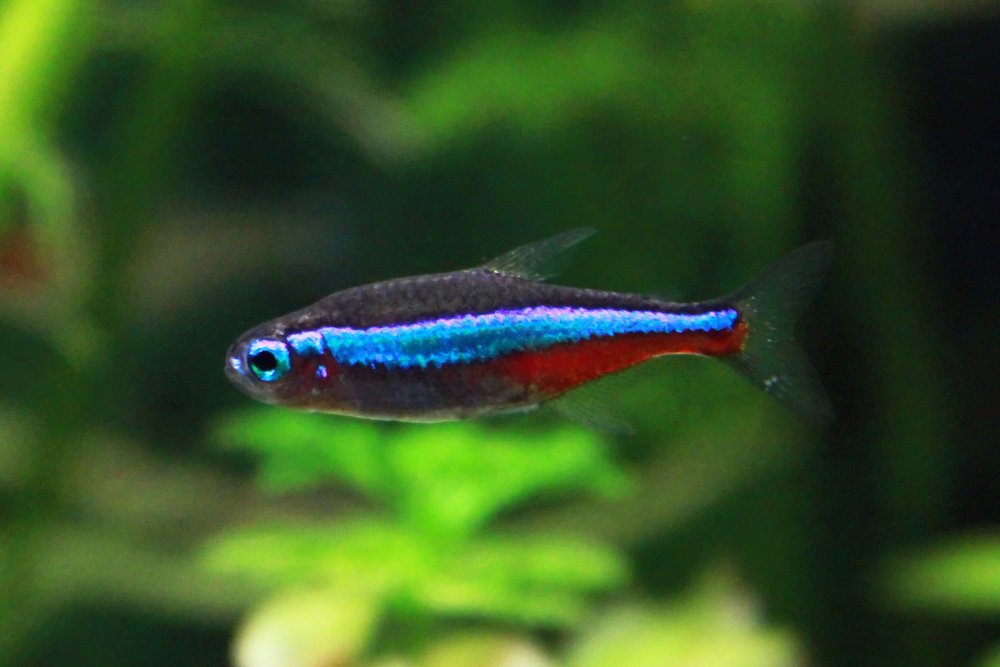
One of the near popular small freshwater fish, Neon Tetra, is native to the blackwater and clearwater Amazon River basin.
Being part of the Characidar family unit, Neon Tetras are small, thin-bodied fish with minor fins and are defined by their neon blue and red color markings.
Every bit a schooling fish, you should continue Neon Tetras in a grouping of at least six in a 10 gallon planted tank. Nevertheless, the larger the tank and shoal, the more interesting and agile they'll be.
A groovy fish for beginners, Neons are hardy, unfussy eaters, and require no specialist equipment.
- Mutual names: Neon Tetra, Neon Fish
- Scientific Proper noun: Paracheirodon innesi
- Life Span:x years
- Size: i.v inches (3 centimeters)
- Minimum tank size: 10 gallons
- Intendance level: Beginner
- Temperament: Peaceful
- Temperature: 72°-76°F (22.two°-24.4°C)
- pH: 6.0-7.0
- Diet: omnivore – high quality flake nutrient, micro pellets or babe alkali shrimp
3. Fundamental Tetras (Paracheirodon Axelrodi)

Some other tiny freshwater nano fish from the Characidae family, the Cardinal Tetra looks very similar to the Neon. Nevertheless, the Cardinal Tetra grows to 2 inches and has bright ventral parts with irised red and blueish stripes running the length of its trunk.
A peaceful shoaling fish, again y'all want to keep a school of at to the lowest degree 6 in a 15 gallon planted customs tank.
They'll exercise well with tank mates like, dwarf gouramis, plecos, rasboras, zebra danio, and other tetra species or peaceful tropical fish. You won't need any special equipment, and can feed an omnivore nutrition of loftier-quality fish food.
- Common names: Cardinal tetra, large neon tetra, red neon, roter neon
- Scientific Name: Paracheirodon Axelrodi
- Life Span: 4 Years
- Size: 2 inches (5 centimeters)
- Minimum tank size: 15 gallons
- Intendance level: Beginner
- Temperament: peaceful
- Temperature: 72°-76°F (22.2°-24.4°C)
- pH: vi.0-vii.0
- Diet: omnivore – high quality flake food, small pellets, brine shrimp and live or frozen daphnia.
4. Bettas (Betta splendens)
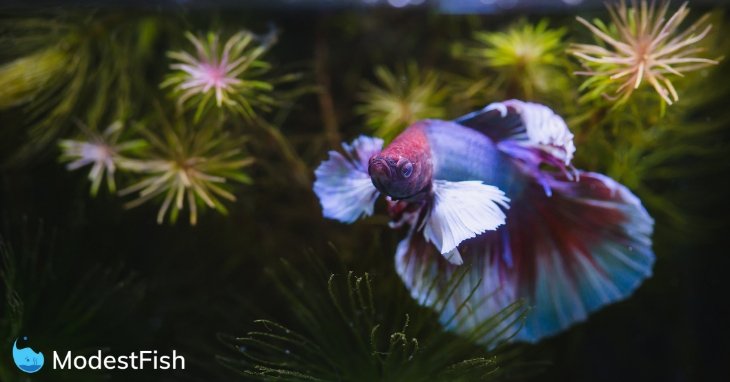
Betta (siamese fighting fish) are a pocket-size tropical fish originating from the tropical waters of Southeast Asia. These tropical fish are known for being fiercely territorial.
There are over 73 varieties of the genus Betta, and are some of the most widely available aquarium fish around the earth. This is downwards to their assortment of vivid colors, large flowing fins, and intelligence.
Betta fish can learn tricks and have the power to recognize and greet their possessor.
Another nifty beginner-fish, you'll want to provide this curious fish with a stimulating environment. A v-gallon planted tank with plenty of decorations to keep this intelligent fish stimulated will continue information technology agile and healthy.
Males should always be housed lone. While females can be kept in a sorority, notwithstanding, I would just recommend this for experienced aquarists.
- Common names: Betta, Siamese fighting fish
- Scientific Name: Betta splendens
- Life Span: 2-5 years
- Size: ii-3 inches (5.seven centimeters)
- Minimum tank size: five gallons
- Care level: Beginner
- Temperament: aggressive, males should be kept alone
- Temperature: 75°-81°F (23.8°-27.2°C)
- pH: half-dozen.5-7.v
- Diet: carnivore – Bettas eat generally insects in the wild so it'southward best to feed them things like Fluval Bug Bites Betta Formula, frozen or freeze dried bloodworms or live daphnia.
5. Harlequin Rasboras (Trigonostigma heteromorpha)

The Harlequin Rasboras is a beautiful freshwater fish with a small lozenge-shaped body with a vibrant ruby coloration and black marker shaped like a funnel (known as a "blackness wedge"), running from their dorsal fins to their tails.
Growing up to two inches, these small active shoaling fish should exist kept in a grouping of at least six in a 10 gallon planted tank. Although, keeping them in a larger grouping in a bigger tank will non merely increase their well-being, simply also from an aesthetic bespeak of view, a big shoal of harlequin rasboras is truly stunning to witness.
- Common names: Harlequin Rasboras, Ruby-red Rasbora
- Scientific Proper name: Trigonostigma heteromorpha
- Life Span: vi years
- Size: 2 inches (5 centimeters)
- Minimum tank size: ten gallons
- Care level: Beginner
- Temperament: peaceful
- Temperature: 72°-81°F (22.2°-27.2°C)
- pH: vi.0-7.v
- Diet: omnivore – high quality flake foods, live or frozen daphnia and bloodworms.
6. Fancy Guppies (Poecilia Reticulata)

Fancy guppies accept been selectively bred through programs to produce a variety of stunning, brilliant colors, pattern combinations, and fin shapes and sizes. As a result, these livebearers are now one of the globe'south most pop small fish for freshwater aquariums.
Guppies are a fish that stays small, growing to around ii inches in length, and are famous for breeding a lot. So they're best kept in small schools of 5 males or one male per 3-4 females.
If you lot're going to house around 5 guppies, a 5-gallon tank will be enough but a 10 gallon would be easier to manage. Guppies love live plants and tropical water parameters.
- Common names: Fancy guppies, guppy, millionfish, rainbow fish
- Scientific Name: Poecilia Reticulata
- Life Span: 2-3 years
- Size: 2 inches (5 centimeters)
- Minimum tank size: 5 gallons
- Care level: Beginner
- Temperament: mostly peaceful. Males can sometimes harass females and each other.
- Temperature: 70°-82°F (21.1°-27.seven°C)
- pH: 7.0-8.0
- Diet: omnivore – micro pellets, loftier quality flake nutrient, frozen brine or mysis shrimp.
7. Endler's Livebearers (Poecilia wingei)

Endler'south are a modest fish native to the Paria Peninsula, Venezuela, and are one of my personal favorite livebearers.
Closely related to guppies (often hybridized with them), male person endler's tin take intense color markings of black, orange, and metallic green. And just like guppies, endler's volition brood a lot. So best to exist kept in a school of all males or one male per iii-5 females.
These peaceful nano fish will thrive in tropical customs tanks, mostly occupying the upper levels of the h2o cavalcade. They require no specialist equipment and will practise well on an omnivore diet consequent with high-quality fish food and some live food like bloodworms.
- Mutual names: Endler's Livebearers, Endler'south
- Scientific Proper noun: Poecilia wingei
- Life Span: 2-3 years
- Size: 1-1.8 inches (2.5-4.5 centimeters)
- Minimum tank size: v gallons
- Care level: Beginner
- Temperament: peaceful
- Temperature: 75°-eighty°F (°-°C)
- pH: 7.0-viii.0
- Diet: omnivore – micro pellets, flake food, frozen bloodworms and mysis shrimp are good choices.
8. Zebra Danios (Danio Rerio)

Zebra Danios, likewise known as zebrafish, belong to the Cyrindae family unit native to S Asia. Information technology's name comes from the v metallic blueish stripes running on the side of its small torpedo-shaped trunk down to the caudal fin.
When housed in a shoals of at least 5 in a xv gallon long aquarium, zebra danios will be extremely agile and playful fish. These fish are a fun improver to whatsoever small tank.
- Common names: Zebra Danio, Zebrafish, Striped Danio
- Scientific Name: Danio Rerio
- Life Span: 5 years
- Size: 2.5 inches (vi.3 centimeters)
- Minimum tank size: xv gallons
- Care level: Beginner
- Temperament: peaceful
- Temperature: 65°-77°F (18.3°-25°C)
- pH: 6.5-7.v
- Diet: omnivore – loftier quality bit nutrient, micro pellets, alive or frozen daphnia or bloodworms.
9. Bluefin Notho (Nothobranchius Rachovii)
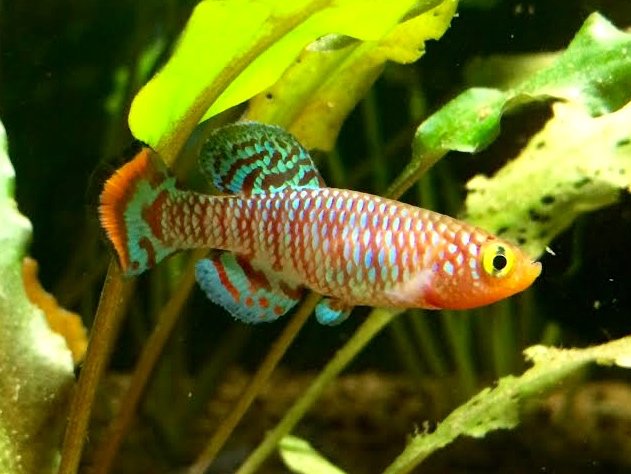
Bluefin Nothos (Rachovii Killifish) are a type of killifish originating from Mozambique, where they live in tiny bodies of water which dry up every twelvemonth, killing the adults and leaving only their eggs. Because of this, Bluefin Notho merely have a lifespan of 1-2 years.
Despite their brusque life span, the bluefin notho is a vibrant nano fish full of life and energy. Brightly colored, with metallic dejection, deep reds, and stripy fins.
They volition exercise best in a 5 gallon tank with tropical h2o parameters and lots of live aquarium plants.
- Common names: Bluefin Notho, Rachovii Killifish
- Scientific Name: Nothobranchius Rachovii
- Life Span: 1-2 years
- Size: ii.four inches (6 centimeters)
- Minimum tank size: five gallons
- Care level: Intermediate
- Temperament: semi-aggressive, especially between males
- Temperature: 68°-75°F (20°-24°C)
- pH: 6.0-7.0
- Diet: predator – frozen and live foods like daphnia, baby alkali shrimp, bloodworms and cyclops
10. White Cloud Mountain Minnow (Tanichthys Albonubes)

1 of the hardiest species of freshwater and coldwater fish, the pocket-size While Cloud Minnow has the ability to accommodate and thrive in a wide range of h2o parameters (45°-70°F).
Growing upwardly to only two inches in length, this slim bodied fish can range from a bright aureate color to a argent blue with bright crimson fins.
They should exist kept in a shoal of at least 6 and volition often exist about agile when housed in cooler water temperatures. When cared for properly, they tin can have a lifespan of up to 5 years or longer.
- Common names: White Deject Minnow, Canton Danio, Chinese Danio, White Deject, White Cloud Mount Fish
- Scientific Name: Tanichthys Albonubes
- Life Span: iii-five years
- Size: ii inches (v centimeters)
- Minimum tank size: 10 gallons
- Care level: Beginner
- Temperament: peaceful
- Temperature: 45°-70°F (7.2°-21.one°C)
- pH: 6.0-8.0
- Diet: omnivore – flakes, micro pellets, alive and frozen daphnia, baby brine shrimp and bloodworms.
11. Celestial Pearl Danio (Danio margaritatus)
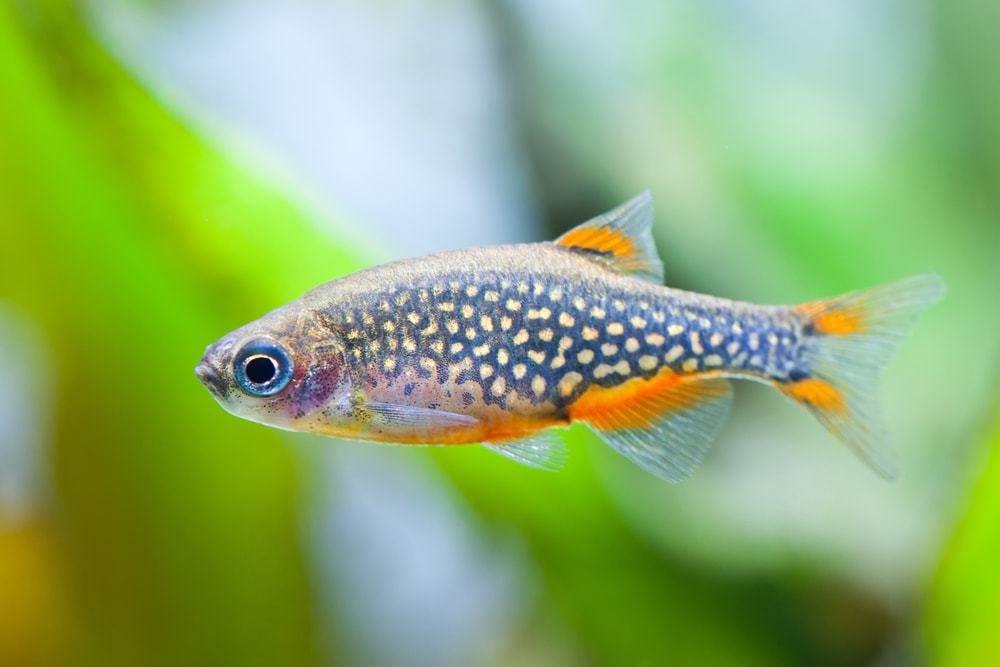
The celestial pearl danio (milky way rasbora), are pocket-size, i inch freshwater fish with a dark blue bod covered in gilded spots.
This aureate color too runs along their backs. Females accept bright orange bases on their fins and tails. Males have large patches of red and blackness on their fins. They are gorgeous.
Not true schooling fish, celestial pearl danios are happier in groups of one male per 3-4 females. Although primarily a peaceful fish, males can become ambitious over females, so keeping this ratio is fundamental to a happy surround.
- Common names: Angelic Pearl Danio, Milky way Rasbora
- Scientific Name: Danio margaritatus
- Life Span: 3-v years
- Size: 1 inch (2.v centimeters)
- Minimum tank size: 10 gallons
- Care level: Intermediate
- Temperament: males will fight over mating rights. Provide lots of hiding places.
- Temperature: 73°-79°F (22.7°-26°C)
- pH: 6.5-vii.5
- Diet: omnivore – bit food, micro pellets, live and frozen foods.
12. Sparkling Gourami (Trichopsis Pumila)

The sparkling gourami (pygmy gourami) has a laterally compressed body with a deep chest that tapers slightly towards the tail.
Their bodies are grey or beige with bright metallic red and/or blue speckles. Their fins and tail are most transparent with rows of more than metallic speckles. Their eyes are big and metallic looking likewise.
A pocket-sized hardy fish, the sparkling gourami is a great choice for a pocket-sized aquarium. A heavily planted, 10 gallon aquarium would exist perfect for a small grouping of 3-five. They can do well in peaceful customs tanks as long as they don't have to compete for food with more aggressive fish.
- Mutual names: Sparkling Gourami, pygmy gourami
- Scientific Name: Trichopsis Pumila
- Life Bridge: 4-five years
- Size: one.5 inches (3.8 centimeters)
- Minimum tank size: 10 gallons
- Intendance level: Intermediate
- Temperament: peaceful
- Temperature: 76°-82°F (24.4°-27.7°C)
- pH: half-dozen.0-seven.0
- Diet: omnivore. This species does best if given a mix of animal protein and algae-based foods: loftier quality customs flake food, spirulina, micro pellets.
14. Pygmy Corydoras (Corydoras Pygmaeus)

Pygmy corys are ambrosial tiny catfish that abound up to i.3 inches. They are agile bottom dwellers that accept a slightly humped back. Their foreheads are steeply sloped upwards to the hump at their dorsal fin.
From at that place, the body tapers down towards the tail. These are great lilliputian cleaner fish and frankly, their beliefs in a large school is pretty funny. They act like a pack of hyper piddling kids let loose in a candy shop.
All-time kept in groups of at least 5 in a ten gallon planted tank. Yet, a larger group (10 or more) in a bigger tank would provide much more activity due to them feeling safer in larger numbers.
A peaceful fish, pygmy corys tin can exist kept with other smaller fish species in a community tank. They'll feed on algae wafers, sinking pellets and dearest a frozen bloodworm.
- Mutual names: Pygmy Corydoras, Pygmy Catfish
- Scientific Name: Corydoras Pygmaeus
- Life Span: three years
- Size: 1.3 inches (3 centimeters)
- Minimum tank size: 10 gallons
- Intendance level: Beginner
- Temperament: peaceful
- Temperature: 72°-79°F (22°-26°C)
- pH: six.iv-seven.4
- Nutrition: omnivore – sinking foods similar pellets and wafers. They likewise love frozen bloodworms and gel foods like Repashy Bottom Scratcher.
15. Otocinclus (Otocinclus Macrospilus)
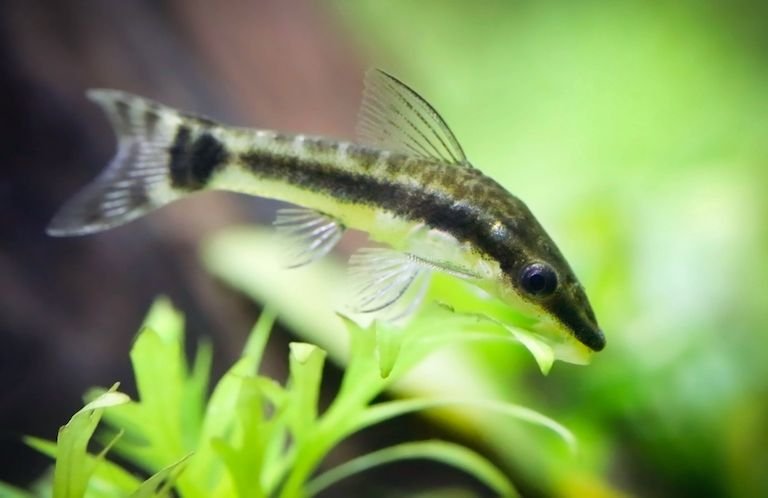
Otocinclus are nano catfish bottom-dwellers famous for their algae consumption. A popular addition to most aquartist clean upwards coiffure, Otos are small beautiful fish that provide plenty of entertainment.
Their wait is characterized past their armour plated body and suckermouths, otocinclus volition stay minor, growing up to two inches in length.
They're easy to intendance for, and are best kept in schools of at least 5 in a 10 gallon planted tank. Still, in the wild they are found in much larger shoals of thousands. And then the larger y'all can do the more agile your Otos will be.
Enough of plants (java moss, java fern, anubias) and hardscape (rocks, driftwood) is ideal, and will go a long fashion to giving this little fish a happy surround.
- Common names: Otocinclus, Oto, Oto true cat, Dwarf Sucker Fish
- Scientific Proper noun: Otocinclus Macrospilus
- Life Bridge: 3-five years
- Size: two inches (five centimeters)
- Minimum tank size: ten gallons
- Intendance level: Beginner
- Temperament: peaceful
- Temperature: 72-82°F (22-28°C)
- pH: 6.0-7.5
Nutrition: plant eater – high quality algae wafer or fair-skinned veggies like broccoli and zucchini.
xv. Dwarf Gourami (Trichogaster lalius)
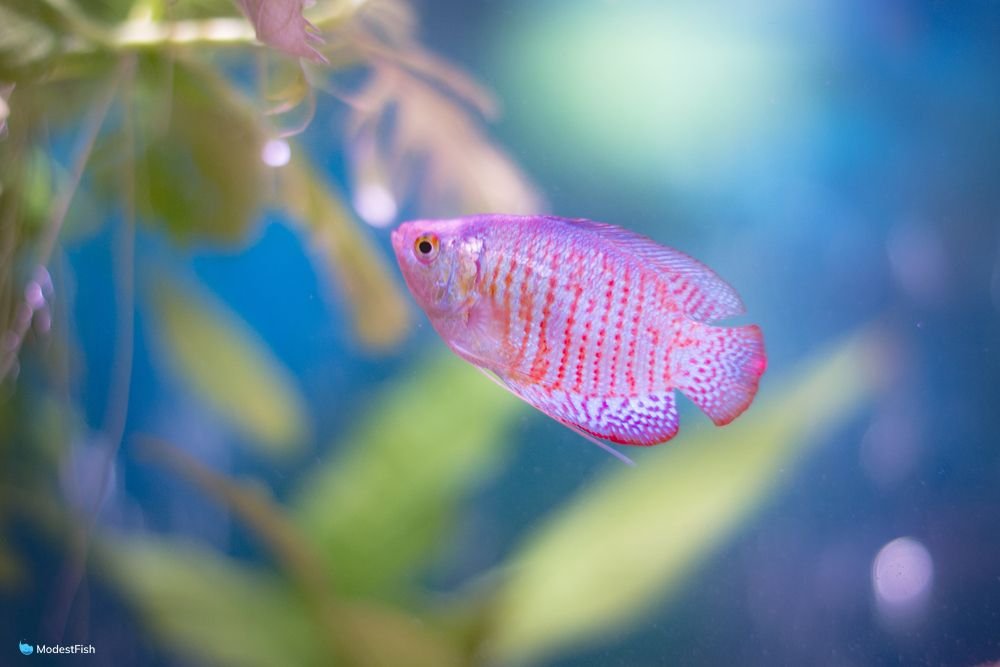
The dwarf gourami is a minor freshwater fish part of the gourami family, growing up to 3.5 inches in length, it'south splendid for small-scale tanks.
This stunning little fish is notable for its vibrant colour variants: blue, flame, neon, dear. Their color combinations brand them a stand out choice for many aquarist's pocket-size nano tanks.
Different the larger aggressive gouramis species, the dwarf gourami is a peaceful community fish. They are ordinarily plant swimming on the upper levels of a tank, so they fit well with mid and lesser home fish.
- Common names: Dwarf Gourami, Flame Gourami, Pulverization Blue Gourami, Red Gourami, Dusk Gourami
- Scientific Name: Trichogaster lalius
- Life Bridge: iv-5 years
- Size: ii-iii.5 inches (8.half dozen centimeters)
- Minimum tank size: 10 gallons
- Intendance level: Intermediate
- Temperament: peaceful
- Temperature: 72-82°F (22-28°C)
- pH: 6.0-seven.5
- Diet: omnivore. Mix of animal poly peptide and algae-based foods: high quality customs flake nutrient, spirulina, micro pellets.
Which Small Fish Is Correct For Your Tank?
There actually are some stunning nano fish bachelor in the freshwater aquarium merchandise. Highlighting these gorgeous small fish shows that dandy things come up in small packages.
When deciding on which fish is best for your small tank, it's important to factor in the needs of the fish you desire to go along. Your best bet is to tailor your tank around the species.
Call back that bigger tanks are really easier to take care of in the long run. Plus, they requite you more room for fish and plants.
Information technology's like shooting fish in a barrel to see why nano tanks have become a craze. They're beautiful but compact enough to fit lots of dissimilar budgets and living situations.
There are so many fun and creative things that can be washed with these smaller tanks, the only limit is your imagination.
Best Fish for 15 Gallon Tall Tank
Posted by: weirnonsts.blogspot.com
0 Response to "Best Fish for 15 Gallon Tall Tank Updated"
Post a Comment